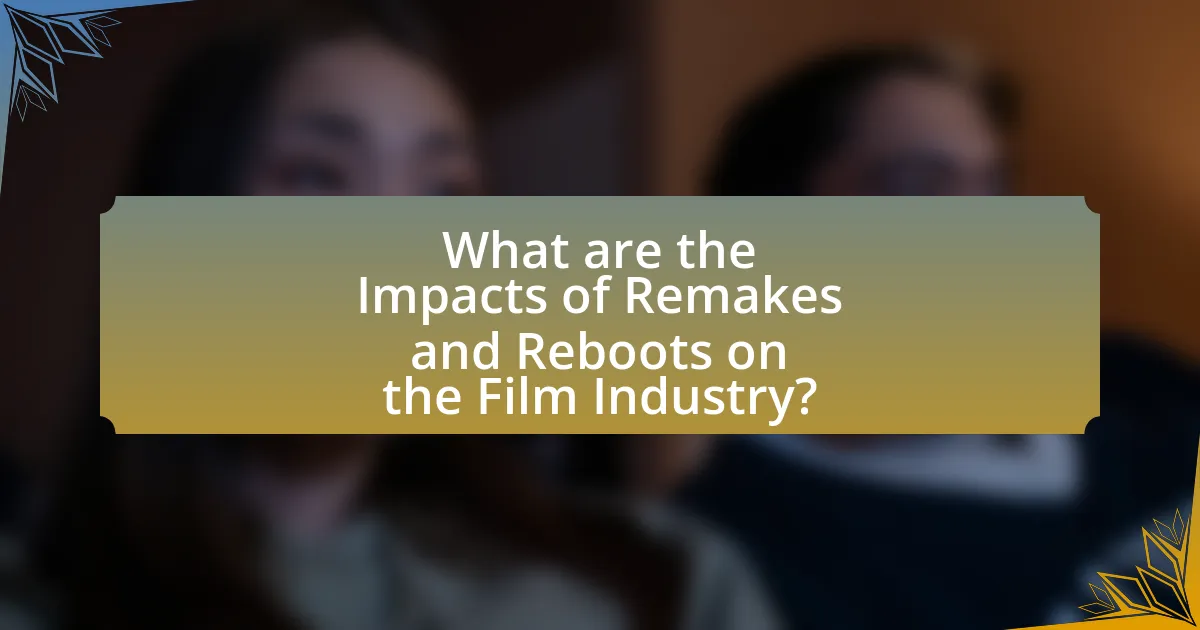The article analyzes the growing trend of remakes and reboots in contemporary cinema, defining remakes as retellings of original stories with updated elements, while reboots reimagine franchises with new narratives. It explores the differences between the two, highlighting their defining characteristics and the factors contributing to their prevalence, such as nostalgia and financial incentives. The article also examines the impacts of remakes and reboots on box office performance, audience engagement, and original content creation, along with critiques regarding originality and quality. Additionally, it discusses strategies filmmakers use to balance nostalgia with innovation, ensuring that remakes and reboots resonate with both existing fans and new audiences.
What are Remakes and Reboots in Today’s Cinema?
Remakes and reboots in today’s cinema refer to the practice of creating new versions of existing films, either by retelling the original story with updated elements (remakes) or by reimagining the franchise with a fresh narrative approach (reboots). Remakes often aim to modernize the original content for contemporary audiences, while reboots typically seek to restart a franchise, often disregarding previous storylines to establish a new direction. For instance, the 2017 remake of “It” revitalized Stephen King’s original 1990 miniseries, achieving significant box office success and critical acclaim, which illustrates the trend’s effectiveness in attracting both new viewers and nostalgic fans.
How do remakes differ from reboots?
Remakes differ from reboots primarily in their approach to existing material; remakes recreate a previous film with a similar storyline and characters, while reboots reimagine the source material, often altering the narrative and character arcs significantly. For example, the 2018 film “A Star Is Born” is a remake of earlier versions, maintaining the core story, whereas the 2016 “Ghostbusters” serves as a reboot, introducing a new premise and characters while referencing the original. This distinction highlights how remakes aim to honor the original work, whereas reboots seek to refresh or redefine the franchise for a new audience.
What are the defining characteristics of a remake?
A remake is characterized by its reimagining of an existing film, often retaining core elements such as the original plot, characters, and themes while updating aspects like technology, cultural context, or artistic style. This process allows filmmakers to reinterpret the source material for a new audience, as seen in successful remakes like “The Lion King” (2019), which utilized advanced CGI to enhance visual storytelling while preserving the original narrative. The defining characteristics also include changes in casting, directing style, and sometimes the addition of contemporary social issues, which can resonate more with modern viewers.
What are the defining characteristics of a reboot?
A reboot is characterized by its intention to restart a franchise or series, often reimagining its narrative, characters, and themes for a contemporary audience. This process typically involves updating the storyline to reflect modern values or technology, while retaining core elements that define the original work. For instance, the 2018 film “Halloween” serves as a reboot by disregarding previous sequels and focusing on the original storyline, thus appealing to both new viewers and long-time fans. Reboots often aim to revitalize interest in a franchise, leveraging nostalgia while introducing fresh perspectives, as seen in the success of the “Spider-Man” reboots, which have attracted diverse audiences across different generations.
Why have remakes and reboots become prevalent in modern cinema?
Remakes and reboots have become prevalent in modern cinema primarily due to their ability to leverage established intellectual properties, which reduces financial risk for studios. This trend is supported by the fact that familiar stories often attract larger audiences, as evidenced by the success of franchises like the Marvel Cinematic Universe and Disney’s live-action adaptations of animated classics, which have grossed billions globally. Additionally, the nostalgia factor plays a significant role; audiences are drawn to reimagined versions of beloved films, creating a built-in fan base that enhances box office potential.
What factors contribute to the rise of remakes and reboots?
The rise of remakes and reboots is primarily driven by nostalgia, financial incentives, and the desire for established intellectual properties. Nostalgia plays a significant role as audiences often seek familiar stories and characters, which can lead to increased box office success. Financial incentives are evident as studios prefer to invest in recognizable brands that have a built-in audience, reducing the risk associated with new, untested concepts. Additionally, the success of previous remakes and reboots, such as the 2017 “It” and the 2019 “The Lion King,” demonstrates a trend where familiar titles can generate substantial revenue, further encouraging studios to pursue similar projects.
How do audience preferences influence the popularity of remakes and reboots?
Audience preferences significantly influence the popularity of remakes and reboots by driving demand for familiar narratives and characters. When audiences express a strong attachment to original films, they create a market for updated versions that resonate with their nostalgia while appealing to contemporary tastes. For instance, the success of the 2017 “It” remake, which grossed over $700 million worldwide, demonstrates how audience familiarity with Stephen King’s original novel and 1990 miniseries fueled interest in the new adaptation. Additionally, audience preferences for diverse representation and modern storytelling techniques can lead to the popularity of reboots that reimagine classic tales, as seen in the 2019 “Aladdin,” which incorporated a more diverse cast and updated themes, resulting in a box office gross of over $1 billion. Thus, audience preferences shape the landscape of remakes and reboots by influencing both their production and commercial success.

What are the Impacts of Remakes and Reboots on the Film Industry?
Remakes and reboots significantly impact the film industry by influencing box office revenues, audience engagement, and creative trends. Financially, remakes often capitalize on established fan bases, leading to higher initial ticket sales; for instance, the 2019 remake of “The Lion King” grossed over $1.6 billion worldwide, demonstrating the profitability of leveraging nostalgia. Additionally, remakes and reboots can shape audience expectations and preferences, as seen with the success of the “Star Wars” sequel trilogy, which revived interest in the franchise and expanded its demographic reach. Creatively, the prevalence of remakes can lead to a reliance on familiar narratives, potentially stifling original storytelling, as evidenced by the increasing number of sequels and adaptations dominating box office charts. Overall, while remakes and reboots can drive financial success and audience engagement, they also raise concerns about originality and innovation within the film industry.
How do remakes and reboots affect box office performance?
Remakes and reboots generally enhance box office performance by leveraging existing brand recognition and audience nostalgia. Historical data shows that films like “Jurassic World” (2015), a reboot of the original “Jurassic Park,” grossed over $1.6 billion worldwide, significantly outperforming many original films released in the same period. Additionally, the 2017 remake of “It” earned $700 million globally, demonstrating that familiar titles can attract larger audiences. This trend indicates that remakes and reboots often benefit from built-in fan bases, leading to higher initial ticket sales compared to original content.
What trends can be observed in the financial success of remakes and reboots?
Remakes and reboots have shown a significant trend of financial success, often outperforming original films at the box office. For instance, films like “The Lion King” (2019) grossed over $1.6 billion worldwide, demonstrating that nostalgia and established fan bases contribute to higher earnings. Additionally, the trend indicates that remakes and reboots tend to attract both older audiences familiar with the original and new viewers, expanding their market reach. Data from the Motion Picture Association shows that sequels, remakes, and reboots accounted for a substantial portion of box office revenue, highlighting their financial viability in contemporary cinema.
How do remakes and reboots influence original content creation?
Remakes and reboots significantly influence original content creation by shaping industry trends and audience expectations. The prevalence of successful remakes, such as “It” (2017) and “A Star is Born” (2018), demonstrates that studios often prioritize familiar narratives to mitigate financial risk, leading to a preference for established intellectual properties over new concepts. This trend can stifle originality, as creators may feel pressured to conform to existing formulas that guarantee audience interest and box office success. According to a study by the University of Southern California, over 70% of films released in recent years are either sequels, remakes, or adaptations, indicating a shift in focus away from original storytelling. Consequently, while remakes and reboots can revitalize interest in classic stories, they also create a landscape where original content struggles to gain traction amidst the dominance of recognizable franchises.
What role do nostalgia and cultural relevance play in the success of remakes and reboots?
Nostalgia and cultural relevance are critical factors in the success of remakes and reboots, as they evoke emotional connections and familiarity among audiences. Research indicates that nostalgia can enhance viewer engagement, leading to increased box office performance; for instance, films like “Jurassic World” and “Ghostbusters” capitalized on nostalgic elements from their original franchises, resulting in substantial financial success. Additionally, cultural relevance ensures that remakes resonate with contemporary societal themes, making them appealing to modern audiences. This combination of nostalgia and cultural relevance not only attracts original fans but also introduces new viewers to the franchise, thereby broadening the audience base and enhancing overall success.
How does nostalgia impact audience reception of remakes and reboots?
Nostalgia significantly enhances audience reception of remakes and reboots by evoking positive emotional connections to original content. This emotional resonance often leads to increased anticipation and acceptance of new adaptations, as audiences seek to relive cherished memories associated with the original works. Research indicates that nostalgia can create a sense of belonging and continuity, making viewers more likely to engage with remakes and reboots favorably. For instance, a study published in the Journal of Consumer Research found that nostalgic feelings can increase consumers’ willingness to pay for products related to their past, suggesting that similar dynamics apply to film adaptations. Thus, nostalgia serves as a powerful tool in shaping audience perceptions and preferences in contemporary cinema.
What cultural factors contribute to the relevance of remakes and reboots?
Cultural nostalgia significantly contributes to the relevance of remakes and reboots, as audiences often seek familiar stories that evoke positive memories from their past. This desire for nostalgia is supported by research indicating that familiarity with original content can enhance viewer engagement and emotional connection, leading to increased box office success. Additionally, the evolution of societal values and norms allows remakes to reinterpret classic narratives, making them more relevant to contemporary audiences. For instance, films like “Ghostbusters” and “Ocean’s 8” have successfully reimagined original concepts with diverse casts, reflecting modern discussions around gender and representation. This blend of nostalgia and contemporary relevance ensures that remakes and reboots resonate with both older and newer generations, solidifying their place in today’s cinema.

What are the Critiques and Challenges Associated with Remakes and Reboots?
Critiques and challenges associated with remakes and reboots include concerns about originality, audience fatigue, and the potential for diminished quality. Critics argue that remakes often lack the creativity of original works, leading to a perception that filmmakers are relying on established franchises rather than innovating. Audience fatigue is evident as viewers may become disenchanted with repetitive themes and familiar storylines, resulting in decreased box office performance. Additionally, the challenge of meeting the expectations of fans of the original material can lead to backlash if the remake or reboot fails to resonate, as seen with films like “Ghostbusters” (2016) and “The Lion King” (2019), which received mixed reviews despite their high-profile status. These factors highlight the complexities filmmakers face when navigating the landscape of remakes and reboots in contemporary cinema.
What are the common criticisms of remakes and reboots?
Common criticisms of remakes and reboots include a lack of originality, reliance on nostalgia, and potential degradation of the source material. Critics argue that many remakes and reboots fail to bring fresh perspectives or innovative storytelling, often rehashing existing plots without adding significant value. For instance, a study by the University of Southern California found that over 70% of films released in recent years are adaptations or sequels, indicating a trend towards recycling ideas rather than creating new content. Additionally, the heavy emphasis on nostalgia can alienate new audiences who may not connect with the original material, while long-time fans may feel that the essence of the original is compromised.
How do critics argue that remakes and reboots lack originality?
Critics argue that remakes and reboots lack originality by highlighting their reliance on existing narratives rather than creating new stories. This perspective is supported by the observation that many remakes often replicate the original plot, characters, and themes, which diminishes the creative process. For instance, a study by the University of Southern California found that over 70% of films released in recent years are either remakes or sequels, indicating a trend towards recycling content instead of fostering innovation in storytelling. This trend leads critics to assert that the film industry prioritizes financial safety over artistic originality, as studios often favor familiar franchises that guarantee audience interest and box office returns.
What are the concerns regarding the quality of remakes and reboots?
Concerns regarding the quality of remakes and reboots primarily include a lack of originality, diminished storytelling, and potential alienation of original fans. Many remakes and reboots often recycle existing narratives without adding new perspectives, leading to criticism for being creatively stagnant. For instance, a study by the University of Southern California found that over 70% of remakes received lower ratings than their original counterparts, indicating a trend of declining quality. Additionally, the reliance on nostalgia can result in a disconnection from contemporary audiences, as seen in the mixed reception of reboots like “Ghostbusters” (2016), which faced backlash for not resonating with both new viewers and fans of the original film.
How do filmmakers address the challenges of creating successful remakes and reboots?
Filmmakers address the challenges of creating successful remakes and reboots by focusing on modernizing the narrative while respecting the original material. They often update themes, characters, and settings to resonate with contemporary audiences, ensuring relevance in today’s cultural context. For instance, the 2017 remake of “It” incorporated modern fears and societal issues, which contributed to its box office success, grossing over $700 million worldwide. Additionally, filmmakers frequently engage with original creators or consult fan communities to maintain authenticity and avoid alienating the existing fan base. This approach helps balance nostalgia with innovation, ultimately leading to a more successful adaptation.
What strategies do filmmakers use to innovate within the remake and reboot format?
Filmmakers innovate within the remake and reboot format by incorporating contemporary themes, diversifying character representation, and utilizing advanced technology. For instance, they often update storylines to reflect current social issues, such as gender equality or racial diversity, which resonates with modern audiences. A notable example is the 2017 remake of “It,” which not only retained the horror elements of the original but also emphasized character development and emotional depth, appealing to a broader demographic. Additionally, filmmakers leverage cutting-edge visual effects and sound design to enhance the cinematic experience, as seen in the 2019 remake of “The Lion King,” which utilized photorealistic animation to create a visually stunning interpretation of the classic. These strategies demonstrate how filmmakers adapt and innovate while respecting the source material, ultimately contributing to the ongoing popularity of remakes and reboots in today’s cinema.
How can filmmakers balance nostalgia with originality in remakes and reboots?
Filmmakers can balance nostalgia with originality in remakes and reboots by integrating familiar elements that resonate with audiences while introducing fresh narratives or perspectives. This approach allows filmmakers to honor the original material, which often holds sentimental value, while also appealing to contemporary viewers’ desire for innovation. For instance, the 2018 film “A Star Is Born” successfully reinterpreted a classic story by incorporating modern themes of mental health and the music industry’s evolution, thus attracting both fans of the original and new audiences. This strategy demonstrates that filmmakers can effectively merge nostalgia with originality, ensuring that remakes and reboots remain relevant and engaging.
What are best practices for engaging audiences with remakes and reboots?
Best practices for engaging audiences with remakes and reboots include updating the narrative to reflect contemporary themes, ensuring high production quality, and leveraging nostalgia while introducing fresh elements. Updating narratives allows remakes to resonate with current societal issues, as seen in films like “It” (2017), which modernized Stephen King’s original story to appeal to a new generation. High production quality, demonstrated by the success of “The Lion King” (2019), enhances viewer experience and attracts audiences. Additionally, leveraging nostalgia effectively, as done in “Ghostbusters: Afterlife” (2021), can draw in fans of the original while introducing new characters and storylines, creating a bridge between generations.


